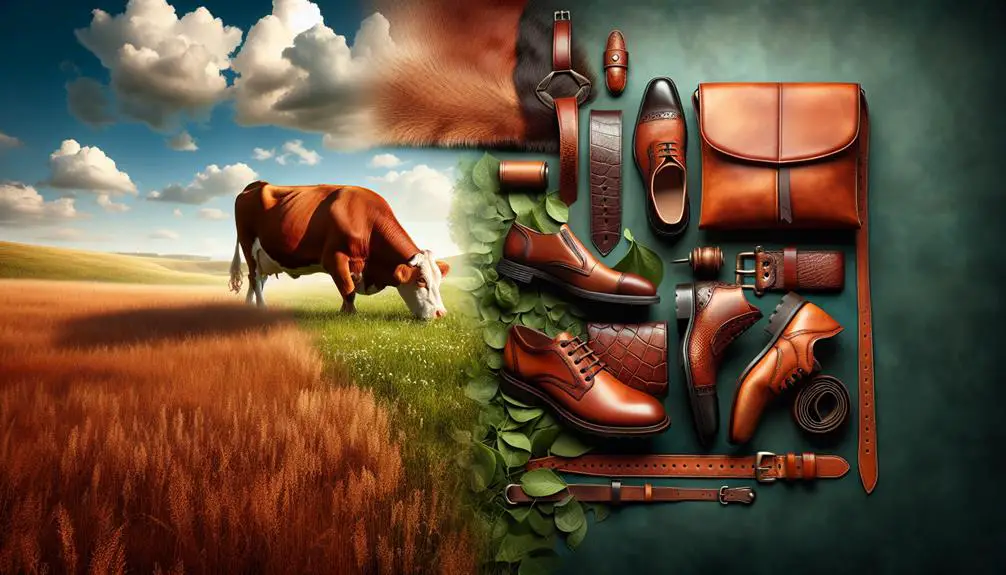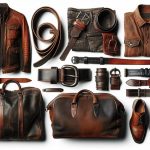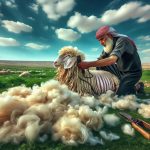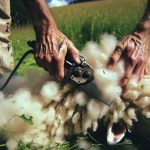I've always wondered exactly what animal leather comes from, and I've found out it's mostly from cows, sheep, pigs, and goats. Each type of animal provides different qualities to the leather. For example, cow leather is super thick and durable, great for things like shoes and belts. Sheep leather, on the other hand, is softer and often used in clothing. Pig and goat leathers are also popular, with unique properties like breathability and water resistance. Some more exotic leathers come from animals like crocodiles or ostriches. There's a whole lot more to discover about where your leather goods might come from!
Table of Contents
Key Takeaways
- Leather primarily comes from cows, sheep, pigs, and goats.
- Exotic leathers are sourced from crocodiles, ostriches, and snakes.
- Leather is a byproduct of the meat industry.
- Different animals provide leather with distinct textures and durability.
- Ethical concerns arise from the use of exotic animal leathers.
Common Leather Sources
Leather comes from a variety of animals, but mostly we get it from cows, sheep, pigs, and goats. These four animals are the backbone of the leather industry, making up over 99% of what's produced globally. Here's why they're so popular.
Cow leather is the heavyweight in the group. It's thick, durable, and incredibly versatile, making it a favorite for everything from sturdy boots to sleek wallets. It's the go-to for items that need to withstand a lot of wear and tear.
Sheep leather, on the other hand, is softer and has a fine grain texture. It's often used in apparel like jackets and gloves due to its pliability and smooth finish.
Pig leather is a bit tougher. It's known for its breathability and ability to hold onto color well. That's why you'll often find it in furniture and shoes.
Lastly, leather from goats isn't as common, but it's prized for its softness and natural waterproof qualities, making it ideal for high-end fashion items.
Each type of leather brings its own unique qualities to the table, offering a wide range of uses that cater to different needs and preferences.
Exotic Leather Varieties
Now, let's talk about the rarer side of leather.
You've got stuff like zebra or crocodile skins, which aren't your everyday leather sources.
These unusual materials often end up in luxury items, pushing the boundaries of typical leather uses.
Rare Leather Sources
I've learned that exotic leather comes from less common sources like zebras, crocodiles, and ostriches. Digging deeper, I found that alligator and crocodile skins are highly prized in fashion, yet the way they're farmed raises serious ethical issues.
Similarly, the demand for snakeskin items often leads to snakes being skinned alive – a process as cruel as it sounds. Ostrich leather is another luxury material, known for its unique texture, but the treatment of these birds in slaughterhouses is nothing short of horrific.
It's clear that the exotic leather industry involves a lot more than just the end products we see in stores; it's a complex issue of animal welfare too.
Unusual Leather Uses
Diving into the world of exotic leathers, we find some truly unusual uses for these materials. Alligator and crocodile skins aren't just tough; they're staples in luxury goods due to their unique, rugged texture. They're super durable, making them perfect for fancy purses and high-end boots.
Ostrich leather, with its cool quill pattern, is a big hit in fashion. It's not only about looks; it's also pretty durable and flexible.
Snakeskin adds that elegant touch to accessories, while zebra leather, though rarer, turns heads with its bold stripes in exclusive fashion lines. Each of these leathers brings something special to the table, blending strength with standout style.
Leather Production Process
Now, let's talk about how leather is actually made.
First off, it starts with sourcing raw materials, which means getting the hides from different animals, like cows or even alligators.
Then, these hides go through a bunch of steps including tanning and finishing to turn them into the leather we use for everything from shoes to sofas.
Raw Material Sourcing
To kick off our discussion on leather production, let's delve into how various animal hides are sourced for this purpose. The vast majority of leather comes from cows, sheep, pigs, and goats. These four animals alone account for over 99% of all leather production globally. Here's a quick look at which animals are primarily used and for what kind of leather:
| Animal | Type of Leather | Common Uses |
|---|---|---|
| Cows | Cowhide Leather | Bags, shoes |
| Sheep | Sheepskin | Coats, hats |
| Pigs | Pigskin | Gloves, bags |
| Goats | Goatskin | Durable items |
Each type of hide offers unique characteristics making them suitable for specific products. Now, let's understand this sourcing a bit more.
Tanning and Finishing Steps
After exploring how animal hides are sourced, let's look at how tanning and finishing steps transform these hides into durable, high-quality leather. Tanning methods are vital; chrome tanning is popular for its quickness and cost-effectiveness. However, for those leaning towards eco-friendly options, vegetable tanning uses natural plant extracts, though it's slower.
In the finishing stage, the leather gets its final glam-up. This includes dyeing, buffing, and polishing to enhance both appearance and texture. This stage is crucial to ensure the leather meets the expected quality standards and is aesthetically pleasing. Whether it's a wallet, jacket, or sofa, these processes ensure that the leather isn't only durable but also looks top-notch.
Tanning and Treatment
Tanning transforms animal hides into leather using methods like chrome-tanning, vegetable-tanning, and aldehyde-tanning. Each method impacts how your leather goods look, feel, and last. Chrome-tanning is quick and gives leather a soft, more colorful finish. Vegetable-tanning, though slower, offers that classic, earthy look and is better for the environment. Aldehyde-tanning is less common but great for making super soft leathers like those used in chamois.
Now, let's talk treatment and preservation. If you've got a leather jacket or sofa, remember, they need a bit of TLC to prevent damage. Without proper care, leather can suffer from red rot, particularly if it's been acid-treated. This deterioration causes the leather to become powdery and crumble – definitely not a good look.
To keep your leather in top shape, use conditioners and protective sprays designed for leather care. These products help maintain moisture and protect against wear and tear. Avoid exposing leather to excessive sunlight or moisture, as these can accelerate aging. Regular maintenance not only keeps your leather looking good but also extends its lifespan, making sure those leather boots or that wallet stays sturdy and stylish for years.
Historical Uses of Leather
Leather's not just for stylish boots and jackets; it's been quite the historical heavy-hitter too.
Think about ancient warriors suiting up in leather armor or medieval scholars flipping through leather-bound books.
Even during the Renaissance, leather was all the rage in fashion, showing up everywhere from belts to elaborate outfits.
Ancient Armor Applications
Throughout history, many ancient civilizations including the Romans, Greeks, and Egyptians used leather armor because it was both durable and flexible. This material was commonly chosen for its ability to provide a lightweight yet sturdy defense. Imagine heading into battle; you'd want something tough enough to withstand a sword or an arrow but also flexible enough so you could move freely. That's where leather came in handy.
Over time, the techniques for crafting leather armor evolved, allowing for more intricate and effective designs. This wasn't just about protection; it was a true art form, reflecting the skills of ancient craftsmen. Leather's role in ancient armor applications highlights its significance beyond just an everyday material—it was essential for survival in many historical contexts.
Medieval Book Bindings
One fascinating use of leather in the Middle Ages was for binding books, enhancing both their durability and aesthetic appeal. These leather book bindings weren't just practical; they were a form of art. Crafted by skilled artisans, the covers protected the pages inside, which was crucial back when books were rarer and highly valued. The leather used added a layer of elegance and prestige, often embossed with intricate designs that made each book unique.
In the medieval period, protecting manuscripts was paramount. Leather provided this protection brilliantly, giving a tough, durable shield against wear and tear. It's incredible to think about how these bindings have preserved so much knowledge through the centuries, all thanks to leather's resilience and the craftsmanship of those early bookbinders.
Renaissance Fashion Influence
During the Renaissance, leather was key in fashion, notably in outfits like doublets and jerkins, and also in accessories such as belts and gloves. The rich texture and durability of leather products made them perfect for the period's style demands.
Using animal skin wasn't just about utility; it was a fashion statement. As tanning techniques evolved, the manufacturing process allowed for softer, more luxurious leather. This wasn't just about making clothes; it was about showcasing status and skill.
Think about it, wearing a finely crafted leather belt or a pair of gloves spoke volumes about your place in society. So, leather in Renaissance fashion really was a big deal, blending functionality with sheer opulence.
Contemporary Leather Goods
Many contemporary leather goods range from stylish jackets and durable bags to trendy shoes and unique accessories. The variety and quality of these products made from common leather are exceptional, largely thanks to advancements in leather crafting. This durable material has stood the test of time, and with stricter environmental regulations, it's becoming even more appealing.
Here's a quick peek at some typical leather goods:
| Item | Material Used |
|---|---|
| Fashion Jackets | Calfskin, Lambskin |
| Luxury Handbags | Cowhide, Ostrich |
| Designer Shoes | Goat, Crocodile Leather |
With this kind of variety, it's easy to find something that's both high-quality and stylish. I've noticed that the feel of a well-crafted leather jacket or the sturdiness of a premium bag really showcases why leather remains a top choice for designers and consumers alike. It's not just about looks; these items are built to last, making them a smart buy in any wardrobe. Plus, the ongoing push for sustainable practices in the leather industry means we're seeing more responsibly created products hitting the market, blending traditional appeal with modern values.
Ethical Considerations
While we appreciate the durability and style of leather goods, it's also important to consider the ethical implications of their production. The reality is, obtaining leather isn't just about using animal skins; it involves significant animal suffering and environmental degradation. Over a billion animals, including cows, pigs, and even exotic creatures like crocodiles, are killed annually for their hides. These animals often endure harsh conditions in overcrowded factory farms where inhumane treatment is common.
Moreover, the process of turning skins into leather includes the use of harmful chemicals, which pose a serious threat to our environment. Tanneries, where these skins are processed, frequently contaminate nearby water sources, impacting both wildlife and human communities.
As someone who's keen on making thoughtful, ethical fashion choices, I'm increasingly drawn to vegan leather options. These alternatives not only prevent animal suffering but also tend to have a lower environmental impact. The shift towards vegan leather is part of a broader movement advocating for more responsible consumption and production practices. By choosing these alternatives, we're not just opting out of a system that harms animals but also promoting a more sustainable approach to fashion.
Leather Care Guidelines
Taking good care of your leather items ensures they last longer and stay looking great. Leather, being a natural skin, requires a bit of TLC to maintain its allure. Here's how I keep my leather in top-notch condition:
- Clean Regularly: I wipe my leather goods with a damp cloth to remove dirt and dust. It's simple but effective.
- Condition Frequently: Conditioning is crucial for keeping the leather soft and supple. I use a quality leather conditioner every few months.
- Avoid Sun and Heat: I make sure to keep leather away from direct sunlight and heat sources to prevent it from drying and cracking.
- Proper Storage: I store leather products in a cool, dry place. This keeps away moisture and prevents mold.
- Rotate Use: I rotate my leather accessories to avoid excessive wear on any particular area.
Leather in Fashion
After covering how to care for leather, let's explore its significant role in fashion. Leather's always had this cool, edgy vibe that designers can't get enough of. Whether it's the smooth sophistication of top-grain leather in a chic jacket or the rugged appeal of goat leather in sturdy boots, leather's versatility is unmatched. It's not just about looks; the durability and flexibility make it ideal for everything from luxury handbags to everyday belts.
Now, consider how each type of leather brings something special to the table. Goat leather, for example, isn't only durable but has a distinctive texture that adds an extra touch of class to smaller items like gloves and wallets. And kangaroo leather? It's surprisingly strong yet lightweight, making it perfect for high-end athletic shoes that need to endure a lot but also offer comfort.
As we dive deeper into the fashion world's love affair with leather, it's clear why this material has stood the test of time. Its ability to elevate any outfit with a hint of luxury and sophistication ensures that leather will continue to dominate the fashion scene. So, whatever the trend, Leather Come, leather stays!
Leather Alternatives
As we shift focus, it's clear that vegan leather alternatives are gaining traction in the fashion industry. With the spotlight on sustainable fashion, many are ditching traditional leather for innovative, cruelty-free alternatives. These alternatives aren't just kinder to animals but are also pushing the boundaries of eco-friendly innovation.
Here's a quick rundown of what's hot in the world of vegan leather alternatives:
- Polyurethane: A versatile synthetic material that's become a staple in vegan fashion.
- Pineapple Leaves: Yep, you read that right. They're not just for pina coladas anymore but also make a sturdy, textured leather-like material.
- Cork: You might know it from wine bottles, but it's making a splash in fashion, providing a natural and renewable resource that's also durable.
- Big Brands' Shift: Giants like Adidas, Nike, and Puma are moving away from animal skins, proving that ethical fashion can also be trendy and desirable.
- Activism Influence: Campaigns and exposés have significantly influenced public opinion and corporate policies towards adopting more ethical practices.
Embracing these vegan leather alternatives means supporting a cruelty-free, environmentally conscious approach to what we wear. It's a win-win for both fashion lovers and the planet!
Reader Comments and Feedback
Let's dive into what you all think about these vegan leather alternatives! The comments have streamed in, and it's clear you're passionate about the options available. Many of you highlighted that understanding the traditional sources—hides and skins from the meat and dairy industries—is crucial. It's sparked a robust discussion on ethical and sustainable choices.
Some of you pointed out that while cowhide dominates, the industry also taps into sheep and goats, mainly for the production of gloves and other soft leathers. This detail isn't just trivia; it shapes how you view the ethics and impact of leather production.
Feedback on vegan leather varied. A few of you championed its lower environmental footprint, while others were skeptical about its durability and feel. The meat industry's byproducts being used to create leather was a sticking point for some. You're asking, if we're already producing meat, isn't it better to use the hides rather than waste them?
It's a complex issue. Each comment adds depth to our understanding, pushing us to think more critically about where our products come from and the impacts of our consumer choices. Keep the insights coming!
Frequently Asked Questions
What Animal Is Leather Made Of?
Leather's made from various animals, mostly cows, but also sheep, goats, and pigs. Exotic leathers come from alligators or snakes. Each type offers different qualities, like durability or softness.
Is Leather From Cows or Horses?
I'd say leather mostly comes from cows. While it can be sourced from horses, cowhide is far more common due to its durability, availability, and cost-effectiveness in the leather industry.
What Animal Leather Is Best?
I'd say cowhide leather tops the list for its durability and comfort, making it ideal for everyday use and high-quality products. It's tough yet stylish, perfect for various applications.
Is 100% Leather Made From Animals?
Yes, 100% leather is definitely made from animals. It involves processing their hides through tanning and other treatments to create durable, quality material used in various fashion and utility products.
- How Does Ring Spun Cotton Affect Garment Fit and Shape Retention? - August 13, 2024
- What Are the Challenges in Producing Ring Spun Cotton? - August 13, 2024
- Is Ring Spun Cotton Suitable for Plus-Size Clothing? - August 13, 2024






